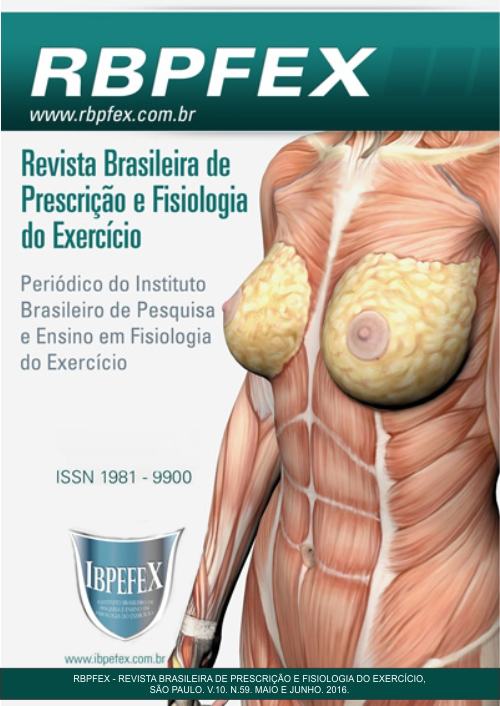Effects of swimming training and creatine supplementation on blood levels of mice lactate
Abstract
Introduction: The use of ergogenic resources associated with the exercise protocols is a crescent, seeking the increased sports performance and aesthetic benefits. Objective: To demonstrate the potential of swimming training protocol and creatine supplementation to alter blood levels of lactate mice. Materials and methods: Swimming training associatedwith creatine supplementation and subsequent effort test on a treadmill to collect lactate. Discussion: Creatine supplementation can act increasing creatine phosphate in muscle, favoring this metabolism and decreasing the formation of lactate. Results: Decrease in blood lactate levels in the group that swimming and the swimming associated with the use of creatine group. Conclusion: With the results we have concludedthat the exercise protocol involving the mode of swimming shows the decreasing potentialofthe accumulation of mice lactate on bloodand creatine supplementation associated with the training protocol enhances the reduction in the accumulation of blood levels of lactate.
References
-Ament, W.; e colaboradores. Exercise and Fatigue. Sports Medicine. Vol. 39. Núm. 5. p. 389-422. 2009.
-Balog, E. M.; e colaboradores. Effects of depolarization and low intracellular pH oncharge movement currents of frog skeletalmuscle fibers. J appl Physiol. Vol. 90. p. 228-234. 2000.
-Baltgalvis, K. A.; e colaboradores. Exercise training improves plantar flexor muscle function in mdx mice. Medicine & Science in Sports & Exercise. Vol. 4. p. 1671-1679. 2012.
-Brooks, G. A. Intra and extracellular lactate shuttles. Med Sci Sports Exerc. Vol. 32. Núm. 2. p. 790-799. 2000.
-Ferreira, J. C. B.; e colaboradores.Maximal lactate steady state in running mice: effect of exercise training. Clin. Exp. Pharmacol. Physiology. Vol. 34. p. 760-765. 2007.
-Fontana, K. E.; e colaboradores. Glutamina como suplemento ergogênico. Rev Bras Ciênc e Mov. Vol. 11. p. 91-96. 2003.
-Kraemer, W.J.; e colaboradores. Hormonal responses and adaptations to resistance exercise and training. Sports Med. Vol. 35. Núm. 23. p. 339-346. 2005.
-Osorio, R.A.; e colaboradores. Swimming of pregnant rats at different water temperatures. Comp BiochemPhysiol A MolIntegr Physiol. Núm. 135. p. 605-611. 2003.
-Peralta, J.; e colaboradores. A creatina como suplemento ergogênico para atletas. Rev Nutr. Vol. 15. Núm.1. p. 83-93. 2002.
-Robergs, R.A.; e colaboradores. Biochemistry of exercise-induced metabolic acidosis. Am J Physiol RegulIntegr Comp Physiol. Vol. 287. Núm. 3. p. 502-516. 2004.
-Souza, R.A.; e colaboradores. Influência da suplementação aguda e crônica de creatina sobre as concentrações sanguíneas de glicose e lactato de ratos wistar. Rev. Bras. Med. Esporte. Vol. 12. Núm. 6. p. 361-365. 2006.
-Voltarelli, F. A.; e colaboradores. Determination of anaerobic threshold inrats using the lactate minimum test. Braz J Med Biol Res. Vol. 35. Núm. 3. p. 1389-1394. 2002.
Authors who publish in this journal agree to the following terms:
- Authors retain the copyright and grant the journal the right of first publication, with work simultaneously licensed under the Creative Commons Attribution License BY-NC which allows the sharing of the work with acknowledgment of the authorship of the work and initial publication in this journal.
- Authors are authorized to enter into additional contracts separately for non-exclusive distribution of the version of the work published in this journal (eg, publishing in institutional repository or book chapter), with acknowledgment of authorship and initial publication in this journal.
- Authors are allowed and encouraged to post and distribute their work online (eg, in institutional repositories or on their personal page) at any point before or during the editorial process, as this can bring about productive change as well as increase impact and impact. citation of published work (See The Effect of Free Access).






